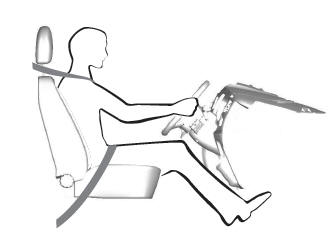Ford Escape: Brakes / Brakes – Troubleshooting
Brakes – Warning Lamps
 If the ABS indicator illuminates
when you are driving, this
indicates a malfunction. Your
vehicle continues to have normal braking
without the anti-lock braking system
function. See an authorized dealer.
If the ABS indicator illuminates
when you are driving, this
indicates a malfunction. Your
vehicle continues to have normal braking
without the anti-lock braking system
function. See an authorized dealer.
It also momentarily illuminates when you switch the ignition on to confirm the lamp is functional. If it does not illuminate when you switch the ignition on, or begins to flash at any time, have the system checked by an authorized dealer.
 The brake indicator momentarily
illuminates when you switch the
ignition on to confirm the lamp
is functional. It may also illuminate when
you apply the parking brake and the
ignition is on. If it illuminates when your
vehicle is moving, make sure the parking
brake is disengaged. If the parking brake
is disengaged, this indicates low brake fluid
level or a brake system fault. See an
authorized dealer.
The brake indicator momentarily
illuminates when you switch the
ignition on to confirm the lamp
is functional. It may also illuminate when
you apply the parking brake and the
ignition is on. If it illuminates when your
vehicle is moving, make sure the parking
brake is disengaged. If the parking brake
is disengaged, this indicates low brake fluid
level or a brake system fault. See an
authorized dealer.
Brakes – Frequently Asked Questions
Is brake dust on the wheels normal?
Brake dust could accumulate on the wheels, even under normal driving conditions. Some dust is inevitable as the brakes wear and does not contribute to brake noise.
Will wet driving conditions effect my braking abilities?
Wet brakes result in reduced braking efficiency. Gently press the brake pedal a few times when driving from a car wash or standing water to dry the brakes.
Is brake noise considered normal?
Occasional brake noise is normal. If a metal-to-metal, continuous grinding or continuous squeal sound is present, the brake linings may be worn-out and an authorized dealer should check them. If the vehicle has continuous vibration or shudder in the steering wheel while braking, an authorized dealer should check your vehicle.
When should you replace the brake fluid?
Brake fluid absorbs water over time which degrades the effectiveness of the brake fluid. Change the brake fluid at the specified intervals to prevent degraded braking performance.
 Locating the Brake Fluid Reservoir. Checking the Brake Fluid.
Locating the Brake Fluid Reservoir. Checking the Brake Fluid.
Locating the Brake Fluid Reservoir
See Under Hood Overview.
Checking the Brake Fluid
WARNING: Do not use any fluid
other than the recommended brake fluid
as this will reduce brake efficiency...
 Electric Parking Brake
Electric Parking Brake
The electric parking brake is used to hold
your vehicle on slopes and flat roads.
Applying the Electric Parking Brake
WARNING: Always fully apply the
parking brake and make sure you shift
into park (P)...
Other information:
Ford Escape 2020-2025 Service Manual: Assembly - Transmission - Plug-In Hybrid Electric Vehicle (PHEV)
Special Tool(s) / General Equipment 204-029Drawbar 205-153 (T80T-4000-W) Handle 307-541Installer, Transfer Gear BearingTKIT-2005D1-F 307-591Shim Gauge, Differential/Transfer Gear BearingTKIT-2006UF-FLMTKIT-2006UF-ROW 307-672Installer, Input Guide and SealTKIT-2010D-FLMTKIT-2010D-ROW 307-680Table, Assembly (DPS6)TKIT-2010D-FLMTKIT-2010D-ROW 307-741..
Ford Escape 2020-2025 Owners Manual: EV Coach - Hybrid Electric Vehicle (HEV)/Plug-In Hybrid Electric Vehicle (PHEV)
EV coach can help you get the most out of your vehicle's electric driving capabilities. Note: EV coach is a selectable screen. See Customizing the Instrument Cluster Display. When you are accelerating or maintaining speed you see a blue or white solid bar indicating vehicle power. You may also see a blue rectangular box which shows the power level at which the engine turns on. When the po..
Categories
- Manuals Home
- 4th Generation Ford Escape Owners Manual
- 4th Generation Ford Escape Service Manual
- Opening and Closing the Hood
- Description and Operation - Identification Codes
- All-Wheel Drive
- New on site
- Most important about car
Sitting in the Correct Position

When you use them properly, the seat, head restraint, seatbelt and airbags will provide optimum protection in the event of a crash.
